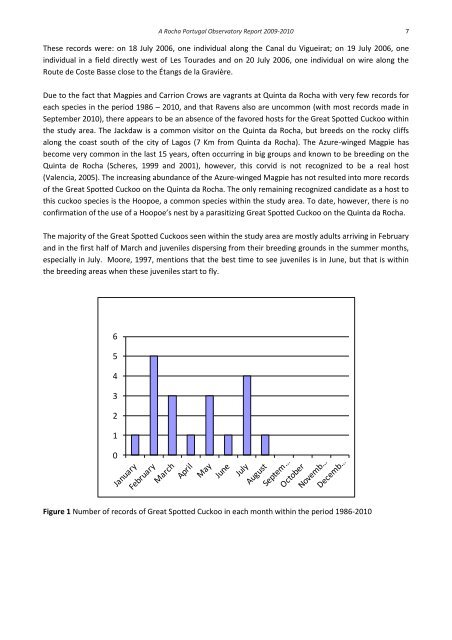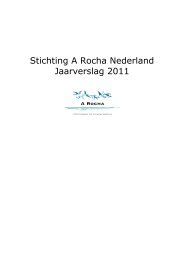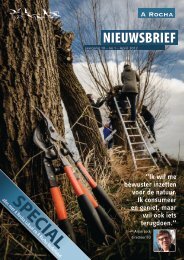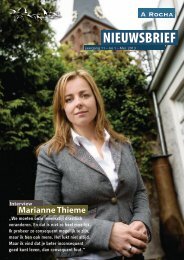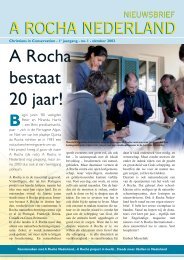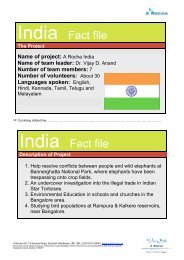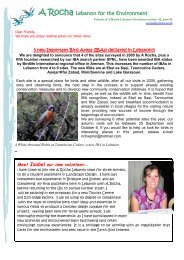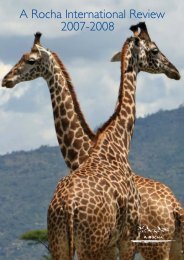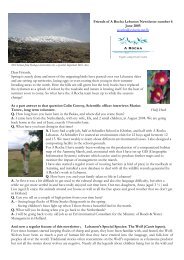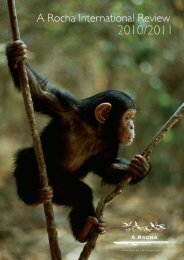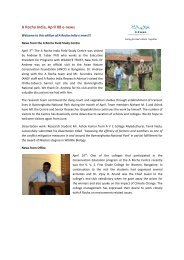A Rocha Portugal Observatory Report 2009-2010
A Rocha Portugal Observatory Report 2009-2010
A Rocha Portugal Observatory Report 2009-2010
You also want an ePaper? Increase the reach of your titles
YUMPU automatically turns print PDFs into web optimized ePapers that Google loves.
A <strong>Rocha</strong> <strong>Portugal</strong> <strong>Observatory</strong> <strong>Report</strong> <strong>2009</strong>-<strong>2010</strong> 7<br />
These records were: on 18 July 2006, one individual along the Canal du Vigueirat; on 19 July 2006, one<br />
individual in a field directly west of Les Tourades and on 20 July 2006, one individual on wire along the<br />
Route de Coste Basse close to the Étangs de la Gravière.<br />
Due to the fact that Magpies and Carrion Crows are vagrants at Quinta da <strong>Rocha</strong> with very few records for<br />
each species in the period 1986 – <strong>2010</strong>, and that Ravens also are uncommon (with most records made in<br />
September <strong>2010</strong>), there appears to be an absence of the favored hosts for the Great Spotted Cuckoo within<br />
the study area. The Jackdaw is a common visitor on the Quinta da <strong>Rocha</strong>, but breeds on the rocky cliffs<br />
along the coast south of the city of Lagos (7 Km from Quinta da <strong>Rocha</strong>). The Azure-winged Magpie has<br />
become very common in the last 15 years, often occurring in big groups and known to be breeding on the<br />
Quinta de <strong>Rocha</strong> (Scheres, 1999 and 2001), however, this corvid is not recognized to be a real host<br />
(Valencia, 2005). The increasing abundance of the Azure-winged Magpie has not resulted into more records<br />
of the Great Spotted Cuckoo on the Quinta da <strong>Rocha</strong>. The only remaining recognized candidate as a host to<br />
this cuckoo species is the Hoopoe, a common species within the study area. To date, however, there is no<br />
confirmation of the use of a Hoopoe’s nest by a parasitizing Great Spotted Cuckoo on the Quinta da <strong>Rocha</strong>.<br />
The majority of the Great Spotted Cuckoos seen within the study area are mostly adults arriving in February<br />
and in the first half of March and juveniles dispersing from their breeding grounds in the summer months,<br />
especially in July. Moore, 1997, mentions that the best time to see juveniles is in June, but that is within<br />
the breeding areas when these juveniles start to fly.<br />
6<br />
5<br />
4<br />
3<br />
2<br />
1<br />
0<br />
Figure 1 Number of records of Great Spotted Cuckoo in each month within the period 1986-<strong>2010</strong>


